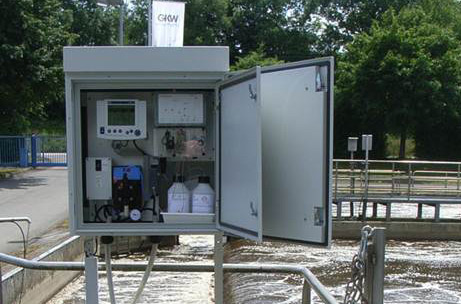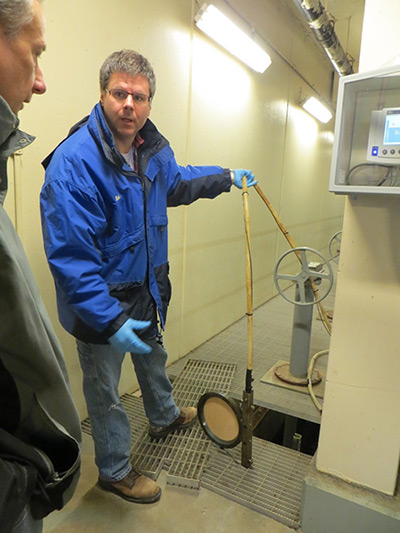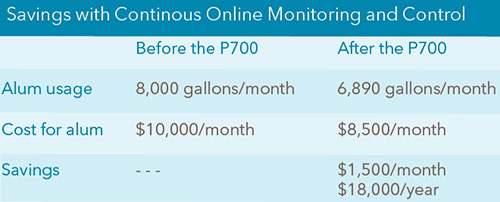Orthophosphate Monitoring for Reduced Chemical Costs
The City of Brookfield covers almost 27 square miles, is home to 40,000 residents, and is a major business, retail, and industrial hub in southeastern Wisconsin. Brookfield is geographically unique because the city straddles the subcontinental divide. The western portion of the city flows to the Fox River Water Pollution Control Center (FRWPCC), operated by the City of Brookfield.

YSI IQ SensorNet P700 Orthophosphate Analyzer
The FRWPCC is an activated sludge plant with tertiary filtration designed for an average daily flow of 12.5 million gallons per day (MGD) and a peak wet weather flow of 50 MGD. The plant complies with a 1.0 mg Total Phosphorus (TP)/L discharge limit by adding alum to secondary treatment (simultaneous precipitation).
The problem with this method is that treatment required an average dosage of over 8,000 gallons per month of alum at a cost that often exceeded $10,000! FRWPCC needed a solution that would reduce chemical usage and, ultimately, save the city money.
The facility was also looking for an overall solution that would allow them to cost-effectively meet a more stringent limit of 0.075 mg TP/L in the future.
Continuous Monitoring Saves the Day
FRWPCC sought ways to reduce chemical usage through better control of the chemical feed. Manual adjustment of the chemical pumps based on infrequent grab sampling tended to err on the conservative side to ensure compliance. However, the result was overdosing and high chemical costs. Continuous monitoring was crucial in determining the correct dosage and proper timing of the alum. 
Rick Wenzel, Process Supervisor for the Control Center, considered many options before recommending the IQ SensorNet P700 Orthophosphate Analyzer from YSI. Low reagent consumption and user-defined automatic calibration to a standard were the key differentiators.
The P700 was installed in the filter building to continuously monitor the orthophosphate concentration in the filtered effluent. The monitoring system consists of a lightweight 0.45-micron sample filter on a slide rail, sample tubing, an IQ SensorNet 2020 controller, and a handrail-mounted cabinet that houses the sample pump, photometer assembly, and reagents.
The phosphate measurement is displayed as PO4-P and the measurement value is reported to the central SCADA system via a 4 20 mA output. The output signal is used to directly control the dosage of alum to the secondary treatment system by adjusting the speed of chemical metering pumps.
Results
The monitoring system has allowed FRWPCC to reduce chemical usage and operating cost and provided valuable insights into treatment dynamics.
Alum usage was reduced by over 5,500 gallons in the first 5 months of operation, saving the District an average of $1,500 per month. This comes to an annual average savings of $18,000.
With the YSI IQ SensorNet P700 Orthophosphate Analyzer, the operators were able to monitor orthophosphate concentrations and adjust the feed pumps based on those measurements.

Figure 1: Phosphate Concentration in Secondary Treatment with the IQ SensorNet P700
Furthermore, the data provided Rick with important information that was missing before.
“I was surprised at how the trend graph looked throughout the day (Figure 1). For instance, we can see the effects of ongoing construction projects and what that is doing to our process.”
The data also revealed regularly occurring peaks, often on weekends, which is attributed to poor aeration control interfering with biological Phosphorus removal. The plant is optimistic that an aeration system overhaul, currently in progress, will correct that situation. Rick and his staff continue to seek ways to improve Phosphorus removal. They are looking into purchasing a second P700 analyzer to monitor the sidestream from digestion and dewatering.
Acknowledgments
Rick Wenzel, Process Supervisor for the Fox River Water Pollution Control Center for providing his experience with the IQ SensorNet System and Sensors.
Additional Blog Posts of Interest
Water Reclamation Facility Meets Discharge Limits for Total Inorganic Nitrogen
Can Smart Devices Enhance Water Resource Recovery Facilities?
Myths and Realities: Ammonium Based Aeration Control in Wastewater
Shortcut the Nitrogen Removal Process in Wastewater with UV Sensors